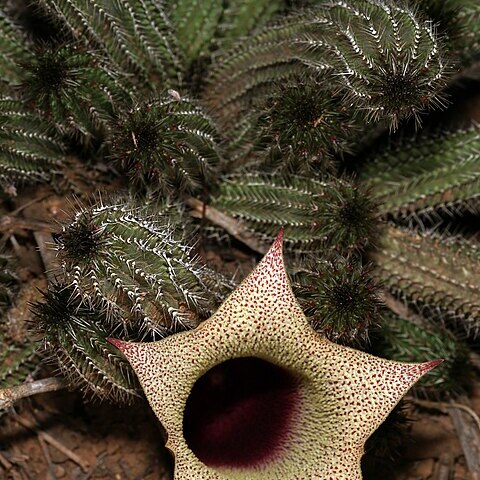Spiny succulent non-rhizomatous shrublet, branching at base to form dense clumps 50 mm-1 m diam. Stems 15-300 mm long, 10-25 mm thick, ± erect from very shortly decumbent base, fleshy and firm, glabrous, green to purplish; tubercles conical, laterally flattened and joined into (8-)10-14 angles up stem, each tipped with 3 bristles (central bristle horizontal, laterals shorter and descending), without stipular denticles. Inflorescence glabrous, 1 per stem, with few flowers developing successively near base of young stems, nearly sessile, with several narrowly lanceolate bracts 3-8 mm long often with lateral teeth; pedicel 5-15 mm long, 1.5-2.0 mm thick, spreading; sepals 5-15 mm long, 1.5-2.5 mm broad at base, lanceolate, acuminate, often spreading towards tips. Corolla 25-150 mm long, 20-80 mm diam., deeply tubular to funnel-shaped, usually initially ascending then spreading or curved downwards towards mouth, rarely straight, very shallowly lobed; outside glabrous, smooth to minutely & sparsely papillate, longitudinally flecked and barred with maroon on cream to greenish; inside densely covered with columnar to clavate papillae (increasing in length towards base of flower) each tipped with a short bristle, with round to longitudinally elongated maroon spots on pale yellow coalescing towards base into dark maroon patch around gynostegium; tube 25-150 mm long, widening gradually from base to 25-45 mm at mouth; lobes 12-25 mm long, 10-20 mm broad at base, deltate, spreading, shortly acuminate, slightly concave from somewhat upturned margins, margins eciliate. Corona 9-18 mm tall, 5-8 mm broad, consisting of 2 series of lobes arising on staminal tube and partly intergrown, seated on short broad and somewhat inflated pentagonal stipe streaked with maroon on white, lower fused parts white, upper filiform parts orange to irregularly striped with maroon on white; outer lobes fused towards base into tube ± half as high as broad, at mouth of this each lobe dividing into 2 erect dorsiventrally flattened filiform segments (often with a third small erect tooth between them) each of which is tipped with a spherical to tear-shaped pendulous knob; inner lobes ±1.5 mm long, adpressed to backs of anthers and sometimes slightly longer than them, linear, dorsiventrally flattened, joined dorsally towards base to inside of outer corona cup, streaked with maroon on white. Anthers descending towards centre of style-head, margins not shrinking back but covering pollinia, ± semicircular. Pollinium D-shaped, longer than broad, insertion-crest twisting from outer edge onto dorsal surface, caudicle attached with broad cupular pad to base. Follicles erect, terete-fusiform, 60-150 mm long, 8-10 mm thick, obclavate, stout, diverging at about 30°, pale cream longitudinally striped with purple-brown, glabrous, smooth.
More
Perennial succulent; stems erect, 0.15-0.30 m high, 10-12-angled, angles with white, tuberculate teeth; each tubercle furnished with 3 apical, purple bristles. Inflorescence 1 per stem with 1-4 flowers produced in succession from near base of stem. Sepals ± ovate-lanceolate. Corolla greenish white with dark red markings on outside, pale yellow with dark red markings within; tube campanulate ± 35 mm long; lobes ± 15 mm long, spreading. Corona outer lobes united at base, each produced into 2 filiform segments sometimes with knob-like apex, ± 7 mm long. Corona: inner lobes united at base to outer corona lobes, linear-lanceolate, incumbent on back of anthers. Staminal column arising from base of corolla. Flowering time midsummer, after rain.
Perennial herb, 75-100 mm high. Stems succulent, with 7-12 tuberculate ribs in cross-section; tubercles with 3 bristles. Leaves rudimentary. Flowers: corona purple-brown; corolla tubular, glabrous, papillate within segments of outer coronal lobes, long attenuate, terminated by subglobose knobs, outside pale greenish or greenish, white spotted with purple-red; inside pale yellowish, with purple-red spots, base purple-red; Nov.-Mar. Fruit a follicle.

